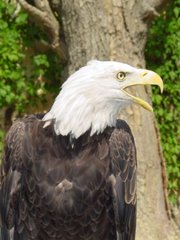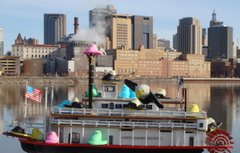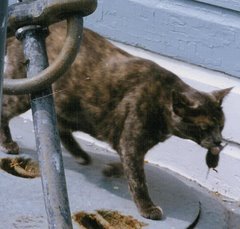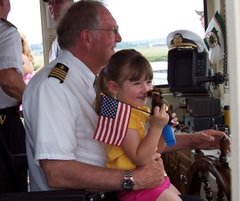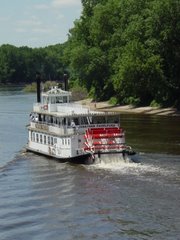
I’ve gotten to know many friendly humans, some noisy ducks, pesky swallows, and a few other interesting animals on Harriet Island since I arrived in Minnesota May 10, 1998.
Looking back I have the strange feeling that the human bean who put me into a cloth bag and threw me into the Mississippi River probably was no friend. I was very small, only a few weeks old at the time. I never saw my brothers and sisters again, but I did manage to claw my way out of the bag and onto the mud. After startling a turtle who immediately abandoned me, plopped into the river and vanished, I managed to crawl under a giant, blue steel staircase.
I was soaking wet, very cold and shaking terribly when these two giant humans thundered down the metal stairway where I was hiding from a nasty looking woodchuck who apparently was already living there. That annoyingly uncontrollable curiosity that so plagues my species forced me to peek out at the humans.
“Hey, look here,” exclaimed the big one called Jim. “It’s one of those baby beavers the boat crew saw last night.”
“Beaver, indeed. I’m no beaver!” I purred angrily, crawled out and puffed out my chest as much as a small feline can.
“No, no it’s a tiny kitten,” the small one called Shelley said softly as she reached down and lifted me from the mud. Her hand was warm and wonderful and she had such a kind, soothing voice I decided maybe all human beans aren’t so bad. I decided to take my chances with Shelley – at the very least her teeth weren’t as big as Woody the woodchuck who was beginning too seriously resent my visit under the blue stairway to the river.
Shelley carried me down into the riverboat company office where she got some paper towels and wiped most of the water and mud off my fur. She sent big Jim away and shortly he returned with a giant bag of kitten food, some milk and a bag of gray dirt. Wow! Maybe he’s not so such a bad guy either – I’ll have to keep an eye on him.
Next they brought in this soft, fuzzy blanket, put it on the floor and sat me on it. My very own bed, can you believe it? Big Jim also put a yellow plastic box filled with the gray sand into the bathroom. He carried me in there and rubbed my face in the sand. I guess these human beans aren’t as smart as they think they are – any dummy knows a litter box isn’t for your nose. I pretended to understand -- no sense embarrassing him when he was trying to be a good guy.
Suddenly it struck me – what’s wrong with this picture? This cannot be true. Only a few hours ago I was nearly dead and now suddenly animals from that same species that I hated so much were treating me like a queen. What’s the catch?
The next two years passed rather uneventfully, if you can call being trapped in a tiny office building on a barge in the Mississippi River with a bunch of riverboat captains, deck hands and office workers uneventful.
It seems that most of these macho riverboat captains didn’t dare admit that they like cats and several of them said some downright nasty things. Funny thing, though! At night and on the quite weekends during the winter months when they would appear alone to check the boats and barges they would talk silly, pet me and make sure I had enough food. Even Capt. Gus who was a proclaimed “cat hater” (YIKES, that is difficult even to think) was my pal when no one else was around.
But without a doubt my best friend in the whole world was Shelley. She became the mother I never knew. Although she is petite (by human bean standards), very quite and mild mannered she is strong and powerful in the office. Whenever someone threatened me she stepped in and that was the end of the threat. She bought me toys and special food, and she brushed me every day.
The only bad thing she ever did to me was the day she appeared with the tiny cage, pushed me inside, carried me out to her car and hauled me up to see this bean with a white coat. There were 13 other cats in this smelly building and they were mumbling something about the needle. I had no idea what that meant. Then suddenly the white coat bean appeared holding an enormous needle. She tried to sweet talk me into relaxing, but I knew this was not going to be a good thing. With the speed of a diving peregrine falcon she plunged the needle into my side. Surprisingly it wasn’t as bad as I had expected. She mumbled a few words to Shelley and we were off again in the car. I don’t know why she put me in that stupid cage.
Over the months I began to grow, and with little or no exercise I grew and grew and grew. Shelley even began to worry about my size. One day she sat me on the postage scale in the office and it rolled up to 14 pounds 11 ounces. “Wow! We need to put you on a diet and get some exercise,” she exclaimed.
Well, we tried running after the ball up and down the hallway for a couple days, but that got pretty boring real fast. Actually, most of my exercise came after the beans went home. Occasionally a bug would wander into the office and provide a pretty good game of hide and seek, but the most fun was when Malcolm, a gray little mouse, appeared. Malcolm thought he was pretty funny the first time we met. I was sound asleep on my fuzzy blanket when he crawled up from the underside of the barge and bit my tail. We raced up and down the hall, over the room dividers and into the front reservation office where Malcolm disappeared down a tiny hole in the corner near the riverside wall. Well, we replayed this routine once or twice a week. A couple times I actually caught Malcolm, but he was a pretty good guy and my only nighttime companion; so, I never harmed him. Although, I did warn him never to bite my tail again or I just might change my mind.
The office barge was an old U.S. Army Corps of Engineers Quartermasters Barge that was built in 1929 and by 1999 the old foundation timbers were beginning to rot. It probably didn’t help much that Malcolm and his family had ripped holes in the baseboard and built a huge network of tunnels for their home just under the floor in the building. So, over the next winter Capt. Gus and his crew built me a brand new home -- a gigantic office with many offices for me to roam throughout the night. It was great but nothing like being freed every morning by Capt. John to roam the park all day. Some of my best friends were three giant dogs and gray cat that strolled down most afternoons from a house up on Winifred St.
Human beans can’t really ever be trusted to be true friends, well, with the possible exception of Shelley, but I did make some pretty fine acquaintances over the years. Paul and Carolyn Verrett would come to visit me almost nightly. Every day during the summer hundreds of humans would come to see me and most of them then went for a riverboat ride. My human friends included Sen. Norm Coleman, Mayor Chris Coleman (no relation, apparently), and Don Shelby, a TV anchor (don’t know good of an anchor he would be inasmuch as he certainly isn’t big enough to hold one of the riverboats in place). People began to call me the queen of Harriet Island. I liked that a lot.
Then one day a strange human bean was visiting the park. I tried my best to be friendly but she took advantage of my kindness, scooped me up and threw me into the back of a big white van. The next thing I knew I was sitting in a cage more disgusting than anything the white coat at the vet clinic could even imagine. All around me were ugly cats and ferocious dogs, a very unpleasant lot to say the least.
After a terrible night suddenly Shelley appeared like an angel to rescue me. We returned to Harriet Island were all was good again until a few months later when it happened all over again. Dragged off to the “dog pound”, now tell me, why do they take a distinguished cat such as me to a place called the “dog pound?” It’s downright humiliating. I was totally embarrassed when Shelley came to my rescue again.
The next day I overheard Shelley and Big Jim whispering “we must do something! She just cannot keep going to the pound and it isn’t right to keep her penned up inside all the time.”
“Oh, oh,” I thought. “This is not good.”
I didn’t hear any more talk and had just begun to relax when Jim picked me up and dropped me into that infernal cage. “Here we go to see White Coat again,” I thought. “Hope there’s no needles.”
But to my shock Jim and Shelley grew quite sad, walked around the office showing me to all of the human beans and then handed me to Julie. She carried me up to her car and we traveled for hours. What can this mean? Where are we headed?
After many hours we arrived at a large place called a farm near the town of Waseca where Julie introduced me to another big man who she called Uncle Richard. He carried me out to an enormous red building where there were monstrously large animals called cows and at least 15 other cats. Well, I’m not terribly fond of cows or cats, so, I struck out on my own and found a rather nice smaller building that was home to many mice. None of the mice were nearly as friendly as Malcolm; so, I had no problem being a bit unkind to them.
At times I really miss the river and my best friend Shelley, but this truly is a great place where I can do anything I choose and roam freely day and night. I love the farm.







